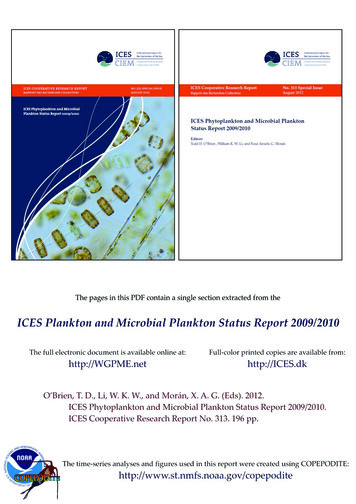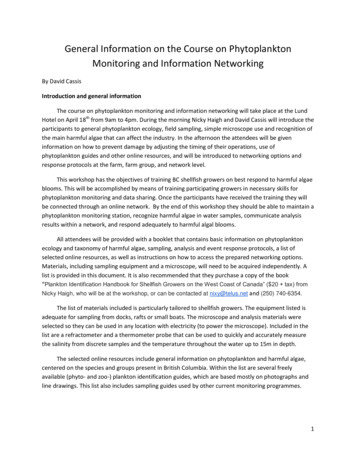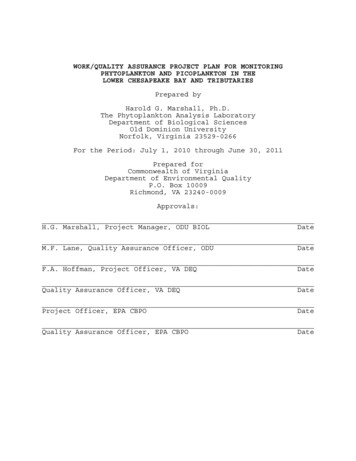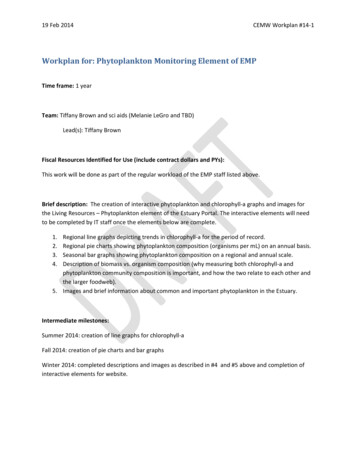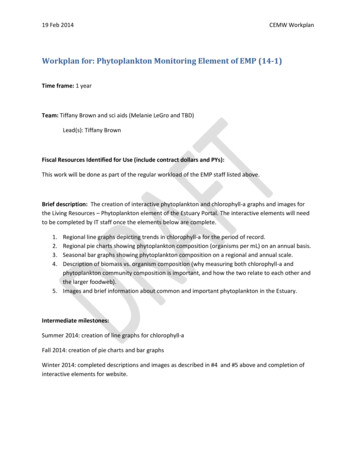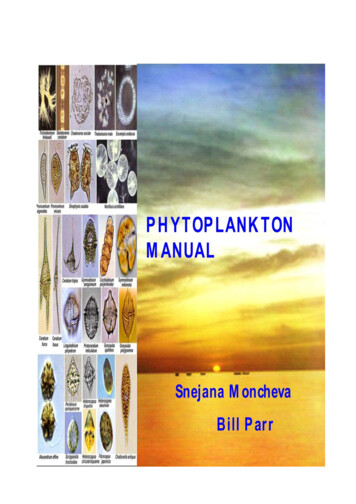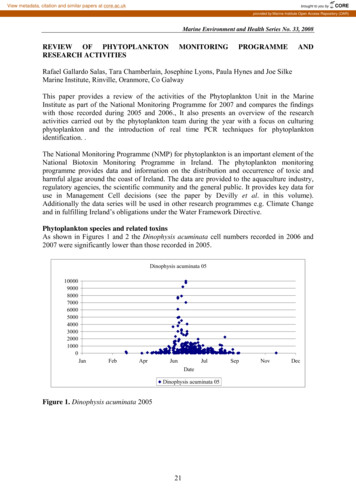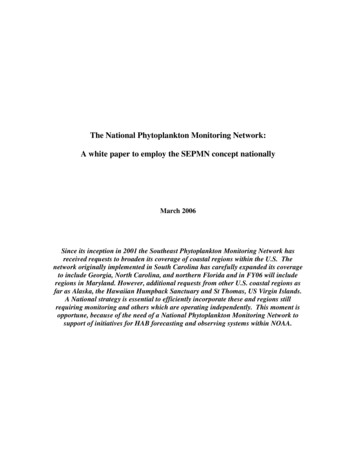
Transcription
The National Phytoplankton Monitoring Network:A white paper to employ the SEPMN concept nationallyMarch 2006Since its inception in 2001 the Southeast Phytoplankton Monitoring Network hasreceived requests to broaden its coverage of coastal regions within the U.S. Thenetwork originally implemented in South Carolina has carefully expanded its coverageto include Georgia, North Carolina, and northern Florida and in FY06 will includeregions in Maryland. However, additional requests from other U.S. coastal regions asfar as Alaska, the Hawaiian Humpback Sanctuary and St Thomas, US Virgin Islands.A National strategy is essential to efficiently incorporate these and regions stillrequiring monitoring and others which are operating independently. This moment isopportune, because of the need of a National Phytoplankton Monitoring Network tosupport of initiatives for HAB forecasting and observing systems within NOAA.
THE SOUTHEAST PHYTOPLANKTON MONITORING NETWORK (SEPMN)In 2001, the South Carolina Phytoplankton Monitoring Network (SCPMN) wasestablished by NOAA’s Marine Biotoxins Program, located at the Center for CoastalEnvironmental Health and Biomolecular Research (CCEHBR) and the Hollings MarineLab (HML) in Charleston, SC, as an outreach program to unite volunteers and scientistsin monitoring the marine phytoplankton community and harmful algal blooms. SCPMNrecruited 10 volunteer groups to sample marine and coastal waters for phytoplankton inorder to learn what types of phytoplankton exist. The program was so successful that itexpanded throughout the coastal regions of the state. In October 2003, a collaborationwith SC Sea Grant’s Center for Ocean Sciences Education Excellence – SouthEast(COSEE-SE) led to a partnership with educators in North Carolina, South Carolina, andGeorgia to form the Southeast Phytoplankton Monitoring Network (SEPMN). To date,there are 62 volunteer groups monitoring 76 sites along the southeast Atlantic coast fromthe northern Outer Banks in North Carolina to Jacksonville, Florida.Volunteers are instructed on algae identification and sample on a weekly orbiweekly basis, reporting their data to researchers at the Marine Biotoxins Program.Each volunteer group is supplied with a plankton net, thermometer, salt refractometer,and an Olympus MIC-D digital microscope. Groups are instructed on the identification of26 species. However, if a species is observed in high abundance which is not on this list,species are preserved and sent to the Marine Biotoxins Program for positiveidentification. Results from volunteer groups enable researchers to identify problem areasto isolate for further study.
The majority of SEPMN volunteer groups include teachers and students in grades5 through 12, however, universities, aquariums, parks and recreational facilities, andenvironmental and citizen groups participate as well. Students and volunteers receivetraining in sampling methods, plankton taxonomy and ecology, microscopy, andphytoplankton identification, and then participate in sampling on a weekly or biweeklybasis, reporting their data to researchers at the Marine Biotoxins Program. During 2005,approximately 3000 participants were actively involved in SEPMN programs andmonitoring activities. Since its inception in 2001, SEPMN volunteers have submittedover 3200 data sets. In this process they have identified 40 harmful algal blooms andgenerated valuable data on species composition and distribution in southeastern coastalwaters.SEPMN MISSON STATEMENT“To educate the public, particularly students, on harmful algal blooms (HABs) whileexpanding the knowledge of phytoplankton that exists in the Southeast Atlantic coastalwaters.”SEPMN GOALS INCLUDE: To create a comprehensive list of marine phytoplankton and potentially harmfulalgal species;To monitor and maintain an extended survey area year-roundTo isolate areas prone to harmful algal blooms (HABs) for further study byresearchers;To identify general trends, such as time and area, where HABs are more likely tooccur;To increase public awareness of phytoplankton and HABs through education andoutreach;To increase public awareness of research conducted by federal, state, and privateresearchers;To support communication and interaction between researchers and the public viaSEPMN volunteers.
A NATIONAL PHYTOPLANKTON MONITORING NETWORK (NPMN)Using the successful monitoring protocols and outreach applications of SEPMNin North Carolina, South Carolina, Georgia and Florida, NOAA would like to expand theconcepts of SEPMN into additional states and regions of the United States. To achievethis goal, two different approaches are proposed: (1) the incorporation of additionalstates into SEPMN and (2) the “franchising” of methods used by SEPMN. Regardless ofapproach, proposed United States regions would include Northeast, Mid-Atlantic,Southeast, Gulf of Mexico, California, Pacific Northwest, Alaska, and Hawaii with thepossibility of future inclusion of monitoring freshwater HABs in the Great Lakes throughthe NOAAs FY08 PPBES for HAB forecasting.Potential Regional Phytoplankton Monitoring NetworksImplementationNOAA will coordinate a workshop and meeting for the coordinators of existingmonitoring networks to encourage collaboration for developing national monitoringprotocols and outreach activities. State stakeholders such as state Department of NaturalResources, phytoplankton researchers and educational specialists would be invited toparticipate in order to ensure that the goals of the monitoring network remain intact. Thenewly-created National Phytoplankton Monitoring Network will have a board of advisorsto ensure the science and education goals for the network are up-to-date with currentresearch and in line with state and national science education standards.NOAA funding will be used to supply sampling equipment, digital microscopes,training, web-based infrastructure, and identification of unknown phytoplankton species.NOAA will provide funding for existing monitoring groups to assist them in aligningtheir monitoring efforts with the goals of SEPMN. Regional and state coordinators
would receive annual training at the NOAA Laboratory in Charleston, SC. A NationalCoordinator would be responsible for organize and conduct one-on-one instruction ofregional coordinators, develop and maintain web-based infrastructure, as well as datamanagement and analyses, newsletter creation, and outreach activities.The incorporation of additional regions within the National PhytoplanktonMonitoring Network will utilize existing infrastructure such as the NOAA’s MarineSanctuaries program (http://www.sanctuaries.nos.noaa.gov/), COSEE Network(http://www.cosee.net), NOAA’s National Estuarine Research Reserve System(http://nerrs.noaa.gov/) NOAA’s SeaGrant Offices, and other NOAA facilities andprograms such as the Oxford Cooperative Laboratory. The NOAA Charleston laboratorywould be responsible for hiring regional and state coordinators. The franchising ofmethods used by SEPMN would allow incorporation of existing monitoring efforts suchas Native American tribes in Alaska and the Pacific Northwest and existing statephytoplankton networks. This method will create a centralized location for the training ofregional coordinators, sharing of methods and protocols, along with web-based GIS anddatabase infrastructure at the NOAA facilities in Charleston, SC. The existing volunteerphytoplankton monitoring networks of Maine, Connecticut, Delaware, Oregon, andCalifornia would be a base group in each region. Regardless of the method of expansion,a NOAA contract employee would coordinate each region in a centralized office. These
regional coordinators would be responsible all aspects of the monitoring network withineach region.Rationale for a National Phytoplankton Monitoring NetworkSimilar state-scale volunteer phytoplankton monitoring networks exist withinMaine, Connecticut, New Hampshire, Delaware, Florida, and California. These stateprograms were initiated in response to specific human disorders caused by blooms ofHAB organisms. For example, the California Phytoplankton Network examines coastalwaters for blooms of the diatom, Pseudo-nitzchia while the Florida Network examinesfor blooms of the dinoflagellate Karenia brevis. Both these programs instruct personnelon the collection of samples which are sent to state researchers for identification. In theNew England states of Maine, Connecticut, and New Hampshire, samples are collectedand identified by volunteers and data is collected by state personnel. These monitoringefforts include both school and civic groups which focuses on known HAB species suchas Alexandrium and Dinophysis. The Delaware program is made of civic groupsmonitoring a number of different species with no involvement with schools. Thestrengths of each program have been incorporated into the SEPMN framework at theinception of the program in 2001. These existing state phytoplankton programs arelimited in scope, participation, and funding.A National Network would provide opportunities for students to participate in areal science research while offering researchers opportunities to not only study the“sentinel” HAB species in their area but to also learn more about the interactions thesesentinel species have with other cosmopolitan algal species. Expanding SEPMN to theNational Phytoplankton Monitoring Network will unite these programs under oneumbrella through collaborating with these existing monitoring programs.Benefits of a National Phytoplankton Monitoring NetworkThe benefits of a National Phytoplankton Monitoring Network would include:1) The identification of algal blooms over a large monitoring area. Theutilization of volunteer monitoring groups is a cost effective means of thedevelopment of a national surveillance of HABs along the coast of the UnitedStates. The observations of blooms will alert state managers and HABresearcher to these events.2) Providing a one-stop depository of HAB data from the volunteers. This willenable for researchers to look at HAB events nationally in one snap shot viaweb-based GIS.3) Samples of blooms reported by volunteers could be collected, preservedand/or cultured for testing of genetic variability, toxin production, etc. Thesesamples would be available to researchers that participate in the nationalmonitoring network.4) Increasing public awareness and interest in HAB events will potentiallyincrease public support for funding HAB research.
5) Creating partnerships between regional phytoplankton monitoring networksand programs such as the Integrated Ocean Observing System.6) The standardization of methods and outreach materials supplied by regionalphytoplankton monitoring networks.7) The National Phytoplankton Monitoring Network would give nationalrecognition to NOAA though innovative outreach and scientific resultsthrough presentation, articles and group interactions.8) Providing volunteer benefits such as teacher professional development,promotion of science careers, improving quality of science education andpublic ocean literacy.ALIGNMENT OF NPMN TO NOAA GOALS AND INITIATIVESAlignment with the National HAB PlanThe NOAA supported national plan directing HAB research, HARRNESS,Harmful Algal Research and Response: A National Environmental Science Strategy2005-2015 recognized the critical need for outreach programs to maintain anddisseminate information about HABs and to produce educational programs to produce agreater community awareness of HABs and a resurgence of stewardship of coastalecosystems. As shown by SEPMN volunteers, students and nonscientists can play animportant role in monitoring coastal waters. Thus, the National PhytoplanktonMonitoring Network offers an ideal pedagogic vehicle to explore the interrelationshipsbetween humans and the coastal environment, at the same time providing students withmeaningful opportunities for hands-on engagement in science. The SEPMN has achievedproven success in outreach and education by directly engaging students, educators, andthe private groups in field sampling and laboratory work.Alignment with NOAA HAB Ecological ForecastingNOAA has conducted nearly a decade of research and monitoring to improveHAB forecasting capabilities and to transfer successful prototype forecasting productsfrom a research to an operational mode within or outside of NOAA. As part of the FY0812 PPBES process, NOAA has identified several transition products for forecasts thatwill become operational. A National Phytoplankton Monitoring Network is oneforecasting product identified for application testing.Alignment with Observing SystemsThe U.S. Commission on Ocean Policy and the National Ocean ResearchLeadership Council identified the Integrated Ocean Observing System (IOOS) as a highpriority for the United States. IOOS is the United States’ contribution to the GlobalOcean Observing System (GOOS), and a contribution to the Global Earth ObservationSystem of Systems (GEOSS). GOOS is currently being designed and implemented tomeet the requirements of a number of international agreements and conventions. NOAAhas been chosen as the lead federal agency and the Co-Chair of the educational andtraining sub-committee of IOOS.
IOOS contain seven societal goals (Weather and Climate, Marine Operations,Natural Hazards, National Security, Public Health, Healthy Ecosystems and SustainedResources) with 20 core variables. Phytoplankton species composition is a key corevariable in 6 of 7 societal goals of IOOS. Collection of salinity and temperature isincluded in every societal goal; each volunteer group which makes up SEPMN collectsboth water temperature and salinity. SEPMN has shown to be a cost effective means ofcollection phytoplankton species composition and environmental parameters such assalinity and temperature. Data collected by volunteer groups can also be utilized to“ground-truth” satellite imagery at the heart of IOOS.Alignment with NOAA’s Educational MissionThe National Phytoplankton Monitoring Network has direct alignments with thefour main strategies detailed in the NOAA Education Plan, identified below:Strategy 1 – Integrate NOAA sciences into high-quality educational material: Thisstrategy statement describes precisely the overall intent of the proposed work. SEPMNhas already created multi-subject/multi-grade level standards-based science curriculumfocused on HABs and phytoplankton. The national expansion will allow for additionalcreation and implementation of high-quality educational materials to be disseminatednationally among formal and informal educators.Strategy 2 - Improve access to NOAA educational resources: This project will notonly develop new educational resources for NOAA, but will make them widely availableonline. This project will also be promoted at various local and national educationalconferences.Strategy 4 – Promote participation in NOAA-related sciences and careers,particularly by members of underrepresented groups: The SEPMN has a proven trackrecord of engaging students in doing science; this project will build upon the Network’ssuccesses by engaging a much larger audience through collaborations with othereducational and scientific groups and organizations as well as the World Wide Web.A student identifying marine phytoplankton in class
ConclusionThe SEPMN concept of linking scientist and volunteer groups has a proven trackrecord of success of raising the awareness of HAB issues and research to a broad range ofcontinuant groups. Teachers who participate in the program have noticed a raise in testscores and general enthusiasm in science education by their students. A number ofknown toxic HAB species have been observed by volunteer groups which were originallynot known to exist in the Southeastern coast of the United States. The creation of aNational Phytoplankton Network would provide opportunities for students to participatein a real science research while offering researchers opportunities to not only study the“sentinel” HAB species in their region but to also learn more about the interactions thesesentinel species have with other cosmopolitan algal species. The goals of the NationalPhytoplankton Monitoring Network are inline with the Ocean Literacy Initiative(www.oceanliteracy.org). Since ocean science is not required in the classroom at anylevel, programs like SEPMN links individual state science standards of biology intoocean sciences. Expanding SEPMN to the National Phytoplankton Monitoring Networkwill unite differing regional phytoplankton monitoring networks under one umbrella toshare facilities, methods, and results.
National Phytoplankton Monitoring Network will unite these programs under one umbrella through collaborating with these existing monitoring programs. Benefits of a National Phytoplankton Monitoring Network . The benefits of a National Phytoplankton Monitoring Network would include: 1) The identification of algal blooms over a large monitoring area.


